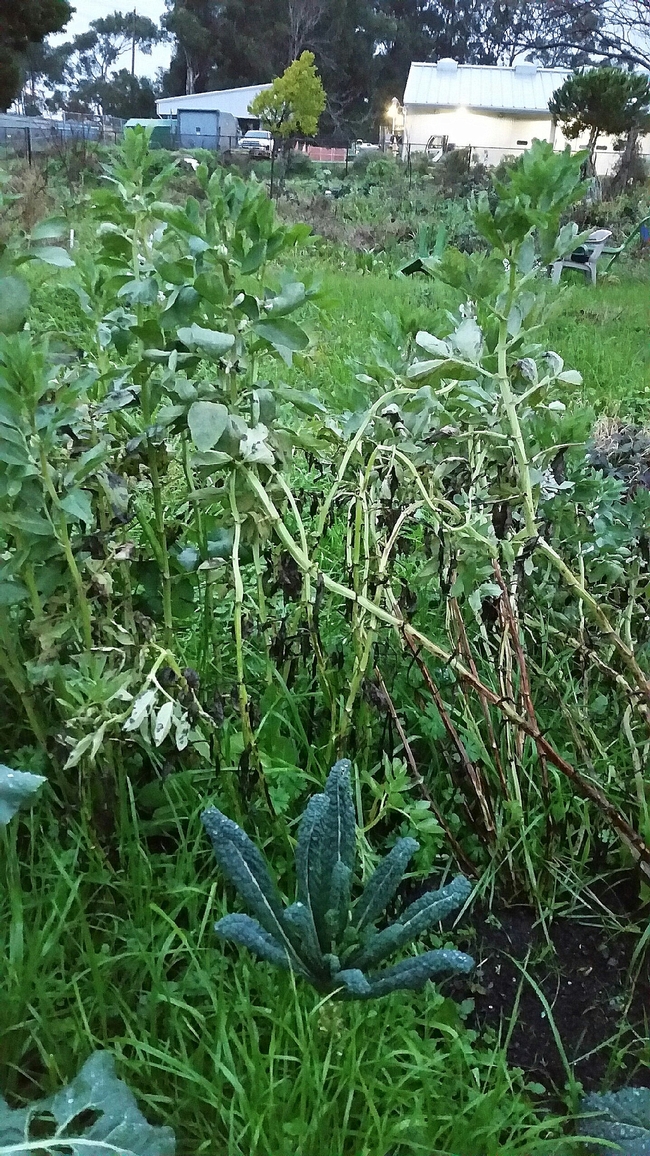Advice from the Help Desk of the
UC Master Gardener Program of Contra Costa
MGCC's Help Desk Response: Thank you for contacting Master Gardeners about your fava beans. And, thank you very much for sending the photo. It was very helpful.
I do not think that the fava beans was damaged by the frost. Frost damage generally appears on the tops of plants rather than the bottoms. Also, fava beans are generally hardy down to 21 degrees. Unless you are in a severe microclimate area, we have yet to see temperatures that low this winter.
Instead, I believe that the beans may have been affected by a fungal disease called Chocolate Spot (Botrytisfabae). Chocolate Spot has been found in fava beans in the northern San Joaquin Valley which is not far from us. Chocolate Spot begins with small red-brown lesions on leaves and stems which can expand and, in an aggressive form, can lead to necrosis (death) of leaves and stem tissue. The aggressive form occurs in high humidity situations, so, if this is the disease you are seeing, it could have come from the earlier rains. I noticed also from the picture that there is a lot of plant material (weeds?) around the fava bean patch which could have also raised or maintained a higher humidity level. It is also possible that this is from some other fungus, but in any case I would suggest hand weeding in the area to increase air circulation to the plants.
With the weeding, it may be possible to save the plants for this year. You have some flowers that would provide you with some beans to enjoy. However, if you are interested in a larger crop you may want to remove these plants now and replant in February or March. That is the planting time for growing fava beans as an edible (as opposed to cover) crop. In either case, once you are done with the plants, I recommend pulling them up and putting them in the commercial green bin for disposal rather than your compost pile. You should also avoid digging them into the soil, since that could cause the fungus to spread.
One other tip: You had mentioned and the photo shows that the plants had fallen over. I have found that to be a common problem with fava beans myself. I use my tomato cages in fava bean patches in my garden to help keep the plants upright.
For more information on fava beans, please see: http://sfp.ucdavis.edu/pubs/brochures/favabean/
While this link is farm-oriented, it has some good background information.
I hope this is helpful. Please let us know if you have further questions or would like more information.
Good luck with your favas!
Help Desk of the UC Master Gardener Program of Contra Costa County (ECS)
Note: The UC Master Gardeners Program of Contra Costa's Help Desk is available year-round to answer your gardening questions. Except for a few holidays, we're open every week, Monday through Thursday for walk-ins from 9:00 am to Noon at 75 Santa Barbara Road, 2d Floor, Pleasant Hill, CA 94523. We can also be reached via telephone: (925) 646-6586, email: ccmg@ucanr.edu, or on the web at http://ccmg.ucanr.edu/Ask_Us/ MGCC Blogs can be found at http://ccmg.ucanr.edu/HortCoCo/ You can also subscribe to the Blog (//ucanr.edu/blogs/CCMGBlog/).